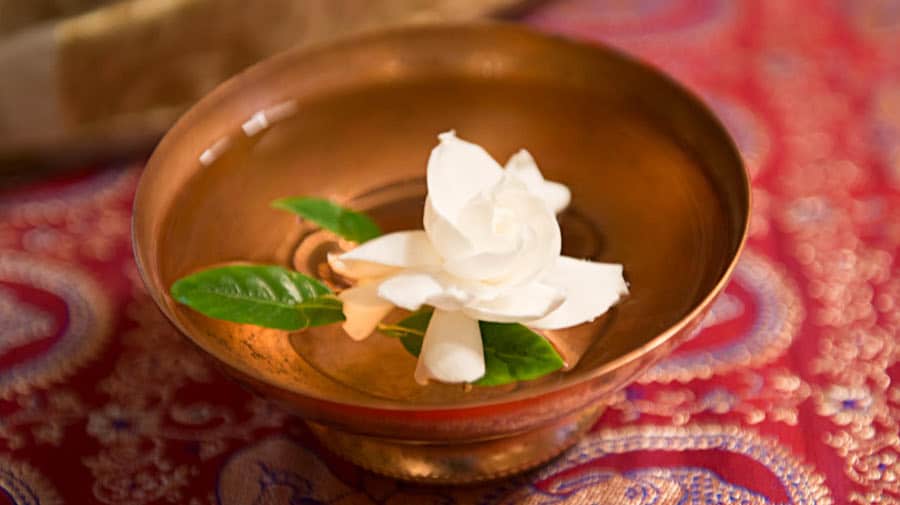You may never meditate, prostrate, or circumambulate. You may not know asana from ascii, or kriyas from Krispy Cremes. But if you have spent any time at all hanging around Hindu or Tantrik types, you have likely performed achamanam.
Achamanam is the sipping of water from the base of the palm of your right hand. It begins any kind of ritual practice.
If you’ve been to one of the hundreds of thousands of temples in India, you have likely been given achamanam by a temple priest.
If you’ve attended a puja, you have been provided with sipping water poured into your palm, usually three times, from an ornate little spoon called the uddharini. Or perhaps there was just a water cooler outside of the ritual area and you noticed everyone taking a sip.
For many of us, achamanam is a feature of daily life.
Achamanam is so simple and quick (like Krispy Cremes), you might be tempted to ignore its deeper significance. But it is a very beautiful and profound practice. The more you investigate achamanam, the richer it becomes.
Most of us are told that achamanam is for self-purification. While this View is not strictly incorrect, our usual understanding of “purification” leads us in the wrong direction.
The concept of purification we generally inherit from our various cultures has to do with ridding ourselves of badness: sin, disease, or just dirt. We get the idea that there is something wrong with us, something inferior as compared to the deities and teachers we invoke during rituals. Measures must be taken to cleanse us before we approach these exalted beings!
From a Tantrik perspective, the only impurity is avidya, or lack of knowledge of our true condition. Impurity is being stuck in a dualistic View. Purity is living with awareness in the open, natural state.
Achamanam is a practice that assists us to surrender avidya, to relax our root sense of separation, and enter into ritual practice having already established ourselves in nonseparative consciousness.
You might find it odd that Tantrik ritual practice begins with entering into nonseparative consciousness. Isn’t that the fruit of the practice? The end product?
Nope. Nonseparative consciousness is not a product at all. It is a pervasive Reality. We do not produce nonseparative consciousness; we discover it.
Performing achamanam at the outset helps us to remember this cosmic fact. It orients us correctly to the entire practice. We are all Shiva.
How does this work?
First, we pour a little spoonful of water into the center of our right palm. We gaze into the water. The water element conveys qualities of pervasion, adapatability, clarity, and continuity. These are aspects of the nonseparative Self. Water is also reflective. In this mirror, we remember our original face.
We then infuse the water with mantra. Different sampradayas (traditions) use different mantras. In our sampradaya, we use mantras signifying Self, cosmic wisdom, and absolute Reality (Shiva Nature). At the end of each mantra, we say “svaha” (pronounced: swaa-ha). Svaha means “I give myself.” So we give our small self to the world Self, cosmic wisdom, and absolute Reality. Our small self dissolves like salt into water.
Sva means self. The sound ha is pure Shakti. Ha is the literal emission of manifest reality. When we pronounce “Svaha,” we are Self emitting Self into Self. We are recognizing ourselves as the world.
To seal the deal, we drink the empowered water from the base of our right palm. The base of the right palm is Brahmatirtha. Tirtha means road or pilgrimage. You can see that it has the famous “ha” sound mentioned earlier. When we drink from this spot, we are actually letting go of all self-limiting karmas and being reborn as the creator.
The sipping is repeated three times. The number three has innumerable meanings including the three gunas (rajas, tamas, and sattva) and the three primordial Shaktis that propel the creation of the world (iccha, jñana, and kriya).
Without achamanam, we are more prey to spiritual materialism. We might practice with the attitude that we are “getting” self-realization. We might think that the practices we do are the cause of this getting of self-realization.
The deeper truth is that spiritual practice serves two functions, neither of them causative.
For a long while, the practices we do are generally geared toward distracting us from our entrenched habits of separative consciousness and helping us to relax our defenses against life.
Practices are for relaxation so that a fuller Reality has room to appear. For instance, if my mind is busy all the time making future plans, how will I hear what the world has planned for me?
But ritual practices are also the vocabulary and grammar of this world’s spiritual language. After a time, we begin to enjoy fuller participation in the world conversation for the benefit of all.
This is stated beautifully in the Bhagavad Gita.
Brahman is the act of offering. Brahman is the oblation poured by Brahman into the fire that is Brahman.
OM Shanti,
Shambhavi

